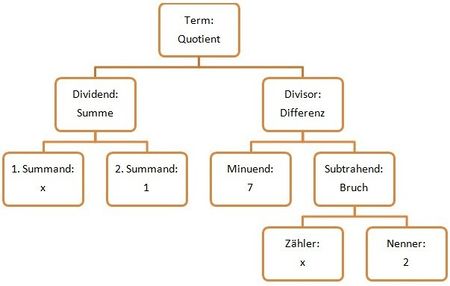Terme/Grundwissenübersicht - Alles auf einen Blick: Unterschied zwischen den Versionen
Keine Bearbeitungszusammenfassung Markierung: 2017-Quelltext-Bearbeitung |
Keine Bearbeitungszusammenfassung |
||
| (Eine dazwischenliegende Version von einem anderen Benutzer wird nicht angezeigt) | |||
| Zeile 13: | Zeile 13: | ||
'''Termart''': Die Termart wird durch das letzte ausgeführte Rechenzeichen festgelegt. ([[Terme/Terme_und_Variablen/Termarten|mehr Information]]) | '''Termart''': Die Termart wird durch das letzte ausgeführte Rechenzeichen festgelegt. ([[Terme/Terme_und_Variablen/Termarten|mehr Information]]) | ||
==Rechengesetze== | ==Rechengesetze== | ||
'''Kommutativgesetz''' | '''Kommutativgesetz''' | ||
* <math> a + b = b + a </math> | |||
* <math> a \cdot b = b \cdot a </math> | *<math> a + b = b + a </math> | ||
: für alle a, b, c <math>\in Q</math> | *<math> a \cdot b = b \cdot a </math> | ||
:für alle a, b, c <math>\in Q</math> | |||
<br /> | <br /> | ||
'''Assoziativgesetz''' | '''Assoziativgesetz''' | ||
* <math> a + (b + c) = (a + b) + c = a + b + c </math> | |||
* <math> a \cdot (b \cdot c) = (a \cdot b) \cdot c = a \cdot b \cdot c </math> | *<math> a + (b + c) = (a + b) + c = a + b + c </math> | ||
: für alle a, b, c <math>\in Q</math> | *<math> a \cdot (b \cdot c) = (a \cdot b) \cdot c = a \cdot b \cdot c </math> | ||
:für alle a, b, c <math>\in Q</math> | |||
<br /> | <br /> | ||
'''Distributivgesetz''' | '''Distributivgesetz''' | ||
| Zeile 31: | Zeile 36: | ||
<div class="grid"> | <div class="grid"> | ||
<div class="width-1-2"> | <div class="width-1-2"> | ||
* <math> a \cdot (b + c) = a \cdot b + a \cdot c </math> | *<math> a \cdot (b + c) = a \cdot b + a \cdot c </math> | ||
* <math> a \cdot (b - c) = a \cdot b - a \cdot c </math> | *<math> a \cdot (b - c) = a \cdot b - a \cdot c </math> | ||
: für alle a, b, c, <math>\in</math> <math>Q</math></div> | |||
:für alle a, b, c, <math>\in</math> <math>Q</math></div> | |||
<div class="width-1-2"> | <div class="width-1-2"> | ||
* <math>\frac{b+c}{a}</math> = <math>\frac{b}{a}</math> + <math>\frac{c}{a}</math> bzw. | *<math>\frac{b+c}{a}</math> = <math>\frac{b}{a}</math> + <math>\frac{c}{a}</math> bzw. | ||
: <math> (b + c) : a = b : a + c : a </math> | |||
* <math>\frac{b-c}{a}</math> = <math>\frac{b}{a}</math> - <math>\frac{c}{a}</math> bzw. | :<math> (b + c) : a = b : a + c : a </math> | ||
: <math> (b - c) : a = b : a - c : a </math> | |||
*<math>\frac{b-c}{a}</math> = <math>\frac{b}{a}</math> - <math>\frac{c}{a}</math> bzw. | |||
:<math> (b - c) : a = b : a - c : a </math> | |||
:für alle a, b, c, <math>\in Q; (a \neq 0) </math> | :für alle a, b, c, <math>\in Q; (a \neq 0) </math> | ||
</div> | </div> | ||
| Zeile 45: | Zeile 54: | ||
==Klammerregeln== | ==Klammerregeln== | ||
*<math> a + (b + c) = a + b + c </math> | |||
*<math> a + (b - c) = a + b - c </math> | |||
*<math> a - (b + c) = a - b - c </math> | |||
*<math> a - (b - c) = a - b + c </math> | |||
*<math> (a + b) \cdot (c + d) = a(c + d) + b(c + d) = ac + ad + bc + bd </math> | |||
*<math> (a - b) \cdot (c + d) = a(c + d) - b(c + d) = ac + ad - bc - bd </math> | |||
*<math> (a + b) \cdot (c - d) = a(c - d) + b(c - d) = ac - ad + bc - bd </math> | |||
*<math> (a - b) \cdot (c - d) = a(c - d) - b(c - d) = ac - ad - bc + bd </math> | |||
{{Lernpfad Terme}} | {{Lernpfad Terme}} | ||
[[Kategorie:Terme]] | [[Kategorie:Terme]] | ||
Aktuelle Version vom 23. April 2022, 16:07 Uhr
Diese Grundwissenseite dient als Übersicht über die wichtigsten Begriffe im Zusammenhang mit Termen.
Begriffe
Term: Ein Term ist ein Rechenausdruck, der einen Sachverhalt beschreibt und neben Zahlen auch Variablen enthalten kann.
Variable: Eine Variable ist ein Platzhalter (häufig Buchstaben), der durch verschiedene Einsetzungen ausgetauscht werden kann.
Definitionsmenge : Die Definitionsmenge ist die Menge der Zahlen, die bei der Einsetzung für eine Variable in einen Term zu einer sinnvollen Aussage führen.
Termwert: Der Termwert ist das Ergebnis, das man erhält, wenn man in den Term eine Zahl der Definitionsmenge einsetzt.
Termart: Die Termart wird durch das letzte ausgeführte Rechenzeichen festgelegt. (mehr Information)
Rechengesetze
Kommutativgesetz
- für alle a, b, c
Assoziativgesetz
- für alle a, b, c
Distributivgesetz
- für alle a, b, c,
- = + bzw.
- = - bzw.
- für alle a, b, c,
Klammerregeln




